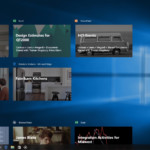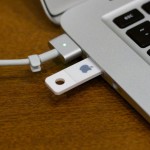Windows 10 Timeline remembers everything you did on your PC
One of the more intriguing features Microsoft will include in this fall's Windows 10 Creators Update is Timeline. As the name suggests, it's a way for you to move backwards in time and see things you were working on in the past and resume what you were doing. Microsoft described it as a visual timeline of everything you were doing on your computer, and you can jump back into files, applications and websites where you left off. Introducing Timeline. Easily jump back in time to continue where you left off. #Windows10 #MSBuild pic.twitter.com/e3gxhXnp6W — Windows (@Windows) May 11, 2017 Timeline lives in the Windows app switcher. When you click it, you'll see your active apps, but below that you'll see what you were running earlier in the day. Clicking down on one of those things that you were using earlier will pop it open just as you were using it before. This works across multiple devices, as well -- when you open up another Windows device where you're signed in, you can resume the tasks you were using before. This will even work across other devices like an iPhone using the Cortana app. If you're somewhere where you have Cortana, it'll prompt you to continue working on whatever you were doing before. If you don't have the specific app installed on your phone, it'll help point you to the right app as well. At first glance, it sounds a little bit like the Time Machine backup feature that Apple has included in macOS for years now. But Time Machine is more of a file backup system that lets you go back and see earlier versions of files that you might want to restore. Microsoft's Timeline covers applications and websites as well as just files, and it doesn't require an external hard drive, as it's not really a true backup system in the way Time Machine is. Indeed, Timeline appears more like Microsoft's answer to Continuity, a feature Apple build into macOS and iOS that lets you pick up and resume work across whatever Apple device you're using. Timeline is just one feature in the forthcoming Creators Update, which features a host of tools for using Microsoft's software and services across devices. The "Microsoft Graph" set of APIs will let you pick up and continue work across multiple devices and will iOS and Android as well as Windows. It'll also let you have a "universal clipboard" across your devices. Click here to catch up on the latest news from Microsoft Build 2017.
Rare Harry Potter Prequel Stolen, J.K. Rowling Pleads for Return
A one-of-a-kind Harry Potter prequel has been stolen, and author J.K. Rowling is eager to get it back in the right hands. Read more...
These Pom-Pom Crabs Are Everybody’s Super Bowl Mascot
Here’s a great cheer for any cheerleading boxer crabs planning to watch the Super Bowl this weekend: Read more...
The Case That Turns Your Phone Into A Polaroid Camera Is Now On Kickstarter
The Prynt case, which lets you print photos directly from your phone, is now available for pre-order on Kickstarter. Read More
RIP PlayStation Home, 2008-2015
PlayStation Home, one of the most ambitious (and weirdest) things Sony has ever done with video games, closes down today. It will not be missed, but it should at least be remembered . Read more...
Apple’s OS X 10.9 may feature Siri and homegrown maps
A new report claims Apple's next OS X release will include built-in Siri -- Apple's voice assistant -- along with the company's own maps application. [Read more]
Today’s Massive Ransomware Attack Was Mostly Preventable—Here’s How To Avoid It
Ransomware may be mostly thought of as a (sometimes costly) nuisance, but when it hinders the ability of doctors and nurses to help people with an emergency medical problems, that qualifies as armed robbery. Read more...
How to make your own bootable OS X 10.10 Yosemite USB install drive
Even in the download-only era, it's easy to make yourself offline OS X install media. Andrew Cunningham It was 2009 when Apple last released a new operating system on physical media . Things have proceeded remarkably smoothly since version 10.7 switched to download-only installers, but there are still good reasons to want an old, reliable USB stick. For instance, if you find yourself doing multiple installs, a USB drive may be faster than multiple downloads (especially if you use a USB 3.0 drive). Or maybe you need a recovery disk for older Macs that don't support the Internet Recovery feature. Whatever the reason, you're in luck, because it's not hard to make one. As with last year , there are two ways to get it done. There's the super easy way with the graphical user interface and the only slightly less easy way that requires some light Terminal use. Here's what you need to get started. A Mac, duh. We've created Yosemite USB from both Mavericks and Yosemite, but your experience with other versions may vary. An 8GB or larger USB flash drive or an 8GB or larger partition on some other kind of external drive. For newer Macs, use a USB 3.0 drive—it makes things significantly faster. The OS X 10.10 Yosemite installer from the Mac App Store in your Applications folder. The installer will delete itself when you install the operating system, but it can be re-downloaded if necessary. If you want a GUI, you need the latest version of Diskmaker X app—we wrote this article based on version 4 beta 2, but if a "final" version is released alongside Yosemite we'll update the article. This app is free to download, but the creator accepts donations if you want to support his efforts. An administrator account on the Mac you're using to create the disk. The easy way Diskmaker X remains the easiest, most user-friendly way to get this done. Andrew Cunningham Once you've obtained all of the necessary materials, connect the USB drive to your Mac and run the Diskmaker X app. The app will offer to make installers for OS X 10.8, 10.9, and 10.10, but we're only interested in Yosemite today. Read 6 remaining paragraphs | Comments
Full-Fledged Windows Apps Could Be Coming Soon To Your Android Phone
If you've ever messed around with Linux, you're probably familiar with a little program called " Wine ," WINdows Emulator/Wine Is Not an Emulator. With its magic, you can run Windows applications on your Linux box (as well as other operating systems), and soon, Wine could be running them on your Android phone as well . More »
New Firefox has no-plugin video-conferencing
Firefox Hello (a Webrtc implmentation) has debuted in the just-released v.34 of the browser, allowing users to conduct peer-to-peer video-chats without any plugins -- just create a chat, send the URL to your friend and start talking. Read the rest












